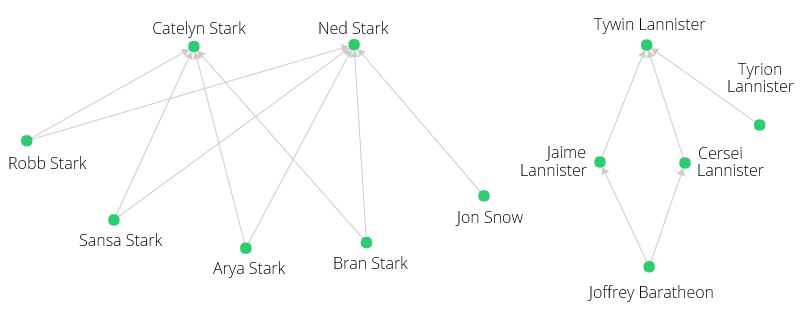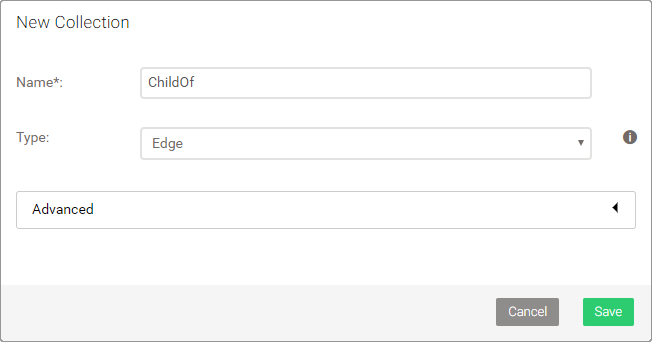Traversal
Relations such as between parents and children can be modeled as graph.
In ArangoDB, two documents (a parent and a child character document) can be
linked by an edge document. Edge documents are stored in edge collections and
have two additional attributes: _from and _to. They reference any two
documents by their document IDs (_id).
ChildOf relationsPermalink
Our characters have the following relations between parents and children (first names only for a better overview):
Robb -> Ned
Sansa -> Ned
Arya -> Ned
Bran -> Ned
Jon -> Ned
Robb -> Catelyn
Sansa -> Catelyn
Arya -> Catelyn
Bran -> Catelyn
Jaime -> Tywin
Cersei -> Tywin
Tyrion -> Tywin
Joffrey -> Jaime
Joffrey -> Cersei
Visualized as a graph:

Creating the edgesPermalink
To create the required edge documents to store these relations in the database,
we can run a query that combines joining and filtering to match up the right
character documents, then use their _id attribute to insert an edge into an
edge collection ChildOf.
First off, create a new collection with the name ChildOf and make sure you change the collection type to Edge.

Then run the following query:
LET data = [
{
"parent": { "name": "Ned", "surname": "Stark" },
"child": { "name": "Robb", "surname": "Stark" }
}, {
"parent": { "name": "Ned", "surname": "Stark" },
"child": { "name": "Sansa", "surname": "Stark" }
}, {
"parent": { "name": "Ned", "surname": "Stark" },
"child": { "name": "Arya", "surname": "Stark" }
}, {
"parent": { "name": "Ned", "surname": "Stark" },
"child": { "name": "Bran", "surname": "Stark" }
}, {
"parent": { "name": "Catelyn", "surname": "Stark" },
"child": { "name": "Robb", "surname": "Stark" }
}, {
"parent": { "name": "Catelyn", "surname": "Stark" },
"child": { "name": "Sansa", "surname": "Stark" }
}, {
"parent": { "name": "Catelyn", "surname": "Stark" },
"child": { "name": "Arya", "surname": "Stark" }
}, {
"parent": { "name": "Catelyn", "surname": "Stark" },
"child": { "name": "Bran", "surname": "Stark" }
}, {
"parent": { "name": "Ned", "surname": "Stark" },
"child": { "name": "Jon", "surname": "Snow" }
}, {
"parent": { "name": "Tywin", "surname": "Lannister" },
"child": { "name": "Jaime", "surname": "Lannister" }
}, {
"parent": { "name": "Tywin", "surname": "Lannister" },
"child": { "name": "Cersei", "surname": "Lannister" }
}, {
"parent": { "name": "Tywin", "surname": "Lannister" },
"child": { "name": "Tyrion", "surname": "Lannister" }
}, {
"parent": { "name": "Cersei", "surname": "Lannister" },
"child": { "name": "Joffrey", "surname": "Baratheon" }
}, {
"parent": { "name": "Jaime", "surname": "Lannister" },
"child": { "name": "Joffrey", "surname": "Baratheon" }
}
]
FOR rel in data
LET parentId = FIRST(
FOR c IN Characters
FILTER c.name == rel.parent.name
FILTER c.surname == rel.parent.surname
LIMIT 1
RETURN c._id
)
LET childId = FIRST(
FOR c IN Characters
FILTER c.name == rel.child.name
FILTER c.surname == rel.child.surname
LIMIT 1
RETURN c._id
)
FILTER parentId != null AND childId != null
INSERT { _from: childId, _to: parentId } INTO ChildOf
RETURN NEW
The character documents don’t have user-defined keys. If they had, it would allow us to create the edges more easily like:
INSERT { _from: "Characters/robb", _to: "Characters/ned" } INTO ChildOf
However, creating the edges programmatically based on character names is a good exercise. Breakdown of the query:
- Assign the relations in form of an array of objects with a parent and
a child attribute each, both with sub-attributes name and surname,
to the
datavariable. - For each element in this array, assign a relation to the
relvariable and execute the subsequent instructions. - Assign the result of an expression to the
parentIdvariable:- Take the first element of a sub-query result (sub-queries are enclosed
by parentheses, but here they are also a function call).
- For each document in the Characters collection, assign the document
to the
cvariable. - Apply two filter conditions: the name in the character document must
equal the parent name in
rel, and the surname must also equal the surname give in the relations data. - Stop after the first match for efficiency.
- Return the ID of the character document (the result of the sub-query
is an array with one element,
FIRST()takes this element and assigns it to theparentIdvariable).
- For each document in the Characters collection, assign the document
to the
- Take the first element of a sub-query result (sub-queries are enclosed
by parentheses, but here they are also a function call).
- Assign the result of an expression to the
childIdvariable.- A sub-query is used to find the child character document and the ID is returned, in the same way as the parent document ID (see above).
- If either or both of the sub-queries were unable to find a match, skip the current relation, because two IDs for both ends of an edge are required to create one (this is only a precaution).
- Insert a new edge document into the ChildOf collection, with the edge going
from
childIdtoparentIdand no other attributes - Return the new edge document (optional).
Traverse to the parentsPermalink
Now that edges link character documents (vertices), we have a graph we can query to find parents of a character – or in graph terms, we want to start at a vertex and follow the edges to other vertices in an AQL graph traversal:
FOR v IN 1..1 OUTBOUND "Characters/2901776" ChildOf
RETURN v.name
This FOR loop doesn’t iterate over a collection or an array, it walks the
graph and iterates over the connected vertices it finds, with the vertex
document assigned to a variable (here: v). It can also emit the edges it
walked as well as the full path from start to end to
another two variables.
In above query, the traversal is restricted to a minimum and maximum traversal
depth of 1 (how many steps to take from the start vertex), and to only follow
edges in OUTBOUND direction. Our edges point from child to parent, and the
parent is one step away from the child, thus it gives us the parents of the
child we start at. "Characters/2901776" is that start vertex. Note that the
document ID is different for you, so please adjust it to your document ID
of e.g. the Bran Stark document:
FOR c IN Characters
FILTER c.name == "Bran"
RETURN c._id
[ "Characters/<YourDocumentkey>" ]
You may also combine this query with the traversal directly to easily change the start vertex by adjusting the filter condition(s):
FOR c IN Characters
FILTER c.name == "Bran"
FOR v IN 1..1 OUTBOUND c ChildOf
RETURN v.name
The start vertex is followed by ChildOf, which is our edge collection. The
example query returns only the name of each parent to keep the result short:
[
"Ned",
"Catelyn"
]
The same result is returned for Robb, Arya and Sansa as a starting point. For Jon Snow, it is only Ned.
Traverse to the childrenPermalink
We can also walk from a parent in the reverse edge direction (INBOUND)
to the children:
FOR c IN Characters
FILTER c.name == "Ned"
FOR v IN 1..1 INBOUND c ChildOf
RETURN v.name
[
"Robb",
"Sansa",
"Jon",
"Arya",
"Bran"
]
Traverse to the grandchildrenPermalink
For the Lannister family, we have relations that span from a parent to a grandchild. Let’s change the traversal depth to return grandchildren, which means to go exactly two steps:
FOR c IN Characters
FILTER c.name == "Tywin"
FOR v IN 2..2 INBOUND c ChildOf
RETURN v.name
[
"Joffrey",
"Joffrey"
]
It might be a bit unexpected, that Joffrey is returned twice. However, if you look at the graph visualization, you can see that multiple paths lead from Joffrey (bottom right) to Tywin:

Tywin <- Jaime <- Joffrey
Tywin <- Cersei <- Joffrey
As a quick fix, change the last line of the query to RETURN DISTINCT v.name
to return each value only once. Keep in mind though, that there are
traversal options to suppress duplicate
vertices early on.
Also check out the ArangoDB Graph Course which covers the basics, but also explains different traversal options and advanced graph queries.
Traverse with variable depthPermalink
To return the parents and grandparents of Joffrey, we can walk edges in the
OUTBOUND direction and adjust the traversal depth to go at least 1 step,
and 2 at most:
FOR c IN Characters
FILTER c.name == "Joffrey"
FOR v IN 1..2 OUTBOUND c ChildOf
RETURN DISTINCT v.name
[
"Cersei",
"Tywin",
"Jaime"
]
If we had deeper family trees, it would only be a matter of changing the depth values to query for great-grandchildren and similar relations.

